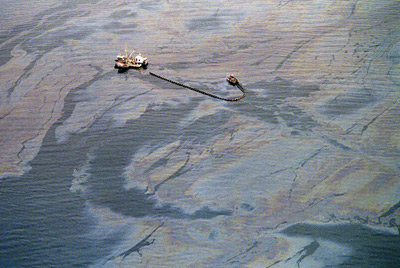Secrecy shrouds decade-old oil spill in Gulf of Mexico
MICHAEL KUNZELMAN, Associated Press
JEFF DONN, Associated Press
OVER THE GULF OF MEXICO (AP) — A blanket of fog lifts, exposing a band of rainbow sheen that stretches for miles off the coast of Louisiana. From the vantage point of an airplane, it’s easy to see gas bubbles in the slick that mark the spot where an oil platform toppled during a 2004 hurricane, triggering what might be the longest-running commercial oil spill ever to pollute the Gulf of Mexico.
Yet more than a decade after crude started leaking at the site formerly operated by Taylor Energy Company, few people even know of its existence. The company has downplayed the leak’s extent and environmental impact, likening it to scores of minor spills and natural seeps the Gulf routinely absorbs.
An Associated Press investigation has revealed evidence that the spill is far worse than what Taylor — or the government — have publicly reported during their secretive, and costly, effort to halt the leak. Presented with AP’s findings, that the sheen recently averaged about 91 gallons of oil per day across eight square miles, the Coast Guard provided a new leak estimate that is about 20 times greater than one recently touted by the company.
Outside experts say the spill could be even worse — possibly one of the largest ever in the Gulf.
Taylor’s oil was befouling the Gulf for years in obscurity before BP’s massive spill in mile-deep water outraged the nation in 2010. Even industry experts haven’t heard of Taylor’s slow-motion spill, which has been leaking like a steady trickle from a faucet, compared to the fire hose that was BP’s gusher.
Taylor, a company renowned in Louisiana for the philanthropy of its deceased founder, has kept documents secret that would shed light on what it has done to stop the leak and eliminate the persistent sheen.
The Coast Guard said in 2008 the leak posed a “significant threat” to the environment, though there is no evidence oil from the site has reached shore. Ian MacDonald, a Florida State University biological oceanography professor and expert witness in a lawsuit against Taylor, said the sheen “presents a substantial threat to the environment” and is capable of harming birds, fish and other marine life.
Using satellite images and pollution reports, the watchdog group SkyTruth estimates between 300,000 and 1.4 million gallons of oil has spilled from the site since 2004, with an annual average daily leak rate between 37 and 900 gallons.
If SkyTruth’s high-end estimate of 1.4 million gallons is accurate, Taylor’s spill would be about 1 percent the size of BP’s, which a judge ruled amounted to 134 million gallons. That would still make the Taylor spill the 8th largest in the Gulf since 1970, according to a list compiled by the National Oceanic and Atmospheric Administration.
“The Taylor leak is just a great example of what I call a dirty little secret in plain sight,” said SkyTruth President John Amos.
Taylor has spent tens of millions of dollars to contain and stop its leak, but it says nothing can be done to completely halt the chronic slicks.
The New Orleans based company presented federal regulators last year with a proposed “final resolution” at the site, but the details remain under wraps. For years, the government has allowed the company to shield other spill-related information from public scrutiny — all in the name of protecting trade secrets.
Industry experts and environmental advocates are baffled by Taylor’s inability to stop the leak and its demands for confidentiality.
“It’s not normal to have a spill like this,” said Ken Arnold, an industry consultant and former engineering manager for Shell Oil Company. “The whole thing surprises me. Normally, we fix things much more quickly than this.”
Five years ago, it took 87 days for BP to cap its blown-out Gulf well and halt the worst offshore oil spill in the nation’s history. The disaster, which killed 11 rig workers, exposed weaknesses in the industry’s safety culture and gaps in its spill response capabilities.
Taylor’s leak provided earlier evidence of how difficult it can be for the industry to prevent or stop a spill in an unforgiving environment. But the company has balked at sharing information that could help other offshore operators prepare for a similar incident, saying it’s a valuable asset.
Whether it can profit from any industry innovations is debatable. The company sold all its offshore leases and oil and gas interests in 2008, four years after founder Patrick Taylor died.
Down to just one full-time employee, Taylor Energy exists only to continue fighting a spill that has no end in sight.
[livemarket market_name="KONK Life LiveMarket" limit=3 category=“” show_signup=0 show_more=0]






No Comment